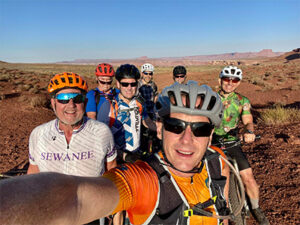Niche lending is an underutilized business strategy for community banks that requires patience, specialized expertise and mastery of the core tenets of banking, according to industry experts and market participants.

Take Southeast Tennessee-based Tower Community Bank. The roughly $400 million institution launched a lending program focused on bicycles a decade ago. CEO Barry Allen sees this kind of program as a continuation of the traditional role community banks have played in allocating unsecured, small-dollar loans. Bicycle loans are underwritten similarly to other unsecured loans, and have lower interest rates than traditional credit cards, Allen noted. “We don’t even think about it as niche lending,” he added. “We’re trying to make loans that best serve our communities, and they just happen to be niche loans. It’s a big deal to us. That’s why we are community bankers.”
Cycle lending is only one part of Tower Community Bank’s tailored lending footprint. The bank also finances medical procedures, funerals, and plans to launch a Latino-focused division this summer in Middle Tennessee. To Allen, the bank’s work with such narrowly defined segments is a key differentiator from larger banks. “They certainly have their place, but they don’t have the bandwidth to be able to do a $3,500 loan for somebody to help plan a funeral, or buy a bicycle, or do braces, or whatever the case may be,” Allen said.
Other community banks with niche lending programs are focusing on a specific type of equipment or industries such as craft breweries and distilleries and health care. One example is Spirit Lake, Iowa-based Bank Midwest. Fourteen years ago, the now-$1.3 billion bank had extra liquidity and room on its balance sheet. Then-CEO Steve Goodenow and an old friend who had worked in equipment leasing began building a nationwide health care equipment finance business.
The bank eventually opted to avoid leasing and instead built a business that today finances equipment for office-based doctors, dentists and veterinarians in all 50 states. Loans help medical offices acquire tools such as ultrasound machines, dental chairs and dermatological lasers.
Oak Park, Ill.-based Evergreen Bank provides powersport vehicle loans while keeping more traditional banking services via its parent brand. Wisconsin’s IncredibleBank focuses on motor home loans and financial advisory services. The Wausau-based $1.4 billion bank partners with mobile home manufacturers and dealers and relies on a mobile banking platform to connect with customers.
Specialized lending can be attractive for deposit-heavy banks that would otherwise heavily invest in long-term Treasuries, said Cornerstone Advisors Senior Director Joel Pruis. Despite the success of banking niche markets and the stated desire of community bankers to focus on commercial and industrial lending, Pruis said only a limited number are involved. “They’re just not in it, and it’s a shame because they should be and there is no reason that they can’t,” he said. “It’s just been that they have been so distracted by the amount of commercial real estate they have been able to do, that they just haven’t put an emphasis on the C&I segments.”
Pruis said larger banks are participating in niche markets as a general course of business, albeit without the specialized partnerships that community banks can leverage as trusted, local advisers. Allen noted that Jasper-based Tower Community Bank offers financing options spread over one to three years, whereas larger banks with bicycle loans typically have terms spread over three to six months.
Banks entering a niche market must first identify the needs of their target customers and evaluate whether they can properly scale the segment, Pruis noted. Bankers must also learn the industry’s broader market trends and be able to explain those to potential customers. At Tower Community Bank, Allen, his predecessor as CEO Geoff Post, and CFO Mark McDougal are all avid cyclists. “There is a product-level knowledge that allows us to do this,” Allen added.
Pruis advised executives to check in with their board members, both to gauge their interest in lending to such micro-segments and to identify relevant opportunities. Tower Community Bank executives used existing relations as a jumping-off point. A decade ago, the bank worked with a Chattanooga, Tenn.-based bicycle shop to finance bicycle purchases and place loan applications in the building.
Pruis noted that smaller banks must be open to expanding the program nationwide to prevent it from being susceptible to local economic risks. Tower Community Bank’s bicycle lending program is currently on pause as it launches a virtual bank and embarks on a partnership with cycling manufacturer Hincapie Sportswear. The bank, which sponsors the Gran Fondo National Series, plans to make bike loan applications available on-site during races. Allen said the partnership could expand the bank’s footprint to South Carolina, Maine, Pennsylvania and California.
Patience is crucial in niche markets: Pruis said it typically takes 18-24 months for banks to see material movement in a portfolio. “You are not going to flip a switch and suddenly get this inflow of new opportunities,” Pruis said. “You have to really get out there and demonstrate that you are serious about it.”
Banks don’t have to focus on just lending to targeted segments: Pruis said they can also learn the other products and services the potential business line needs to provide a more personalized financing package.
According to digital banking platform Narmi, banks should consider lending for underserved communities, including Black and Latino Americans and migrants. By leveraging customer feedback, banks can create a product that services a specific market.
“Leveraging your customer and member data can come in handy to suggest which steps to take next to best reflect the needs of your community,” Narmi stated. “You might also look a bit farther afield. What segments of the population are you not serving, and is there an opportunity to attract and serve those communities? Have you considered business banking opportunities?”
